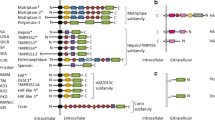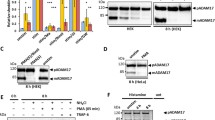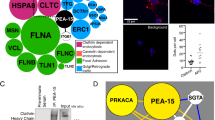Abstract
A group of type II integral serine proteases, including dipeptidyl peptidase IV (DPP4/CD26), seprase/fibroblast activation protein α (FAPα) and related type II transmembrane prolyl serine peptidases, exert their mechanisms of action on the cell surface. DPP4 and seprase exhibit multiple functions due to their abilities to form complexes with each other and to interact with other membrane-associated molecules. Localization of the protease complexes at cell surface protrusions, called invadopodia, may have a prominent role in processing soluble factors (including chemokines and neuropeptide Y) and in degrading locally extracellular matrix components, that are essential to the cell migration and matrix invasion occurring during tumor invasion, angiogenesis and metastasis.
Similar content being viewed by others
References
Hopsu-Havu VK, Glenner GG: A new dipeptide naphthylamidase hydrolyzing glycyl-prolyl-beta-naphthylamide. Histochemie 7: 197–201, 1966
Barrett AJ, Rawlings ND: Oligopeptidases, and the emergence of the prolyl oligopeptidase family. Biol Chem Hoppe Seyler 373: 353–360, 1992
Abbott CA, McCaughan GW, Gorrell MD: Two highly conserved glutamic acid residues in the predicted beta propeller domain of dipeptidyl peptidase IV are required for its enzyme activity. FEBS Letters 458: 278–284, 1999
Sedo A, Malik R: Dipeptidyl peptidase IV-like molecules: Homologous proteins or homologous activities? Biochim Biophys Acta 1550: 107–116, 2001
Goldstein LA, Ghersi G, Pinñeiro-Saánchez ML, Salamone M, Yeh YY, Flessate D, Chen W-T: Molecular cloning of seprase: A serine integral membrane protease from human melanoma. Biochimica et Biophysica Acta 1361: 11–19, 1997
David F, Bernard AM, Pierres M, Marguet D: Identification of serine 624, aspartic acid 702, and histidine 734 as the catalytic triad residues of mouse dipeptidyl-peptidase IV (CD26). A member of a novel family of nonclassical serine hydrolases. J Biol Chem 268: 17247–17252, 1993
Hooper JD, Clements JA, Quigley JP, Antalis TM: Type II transmembrane serine proteases. Insights into an emerging class of cell surface proteolytic enzymes. J Biol Chem 276: 857–860, 2001
Yaron A, Naider F: Proline-dependent structural and biological properties of peptides and proteins. Crit Rev Biochem Mol Biol 28: 31–81, 1993
Morimoto C, Schlossman SF: CD26: A key costimulatory molecule on CD4 memory T cells. Immunologist 2: 4–7, 1994
Ghersi G, Chen W-T, Lee EW, Zukowska Z: Critical role of dipeptidyl peptidase IV in neuropeptide Y-mediated endothelial cell migration in response to wounding. Peptides 22: 453–458, 2001
Vivier I, Marguet D, Naquet P, Bonicel J, Black D, Li CX, Bernard AM, Gorvel JP, Pierres M: Evidence that thymocyte-activating molecule is mouse CD26 (dipeptidyl peptidase IV) J Immunol 147: 447–454, 1991
Pineiro-Sanchez ML, Goldstein LA, Dodt J, Howard L, Yeh Y, Tran H, Argraves WS, Chen W-T: Identification of the 170-kDa melanoma membrane-bound gelatinase (seprase) as a serine integral membrane protease. J Biol Chem 272: 7595–7601; Correction (1998) J Biol Chem 273, 13366, 1997
Johnson RC, Zhu D, Augustin-Voss HG, Pauli BU: Lung endothelial dipeptidyl peptidase IV is an adhesion molecule for lung-metastatic rat breast and prostate carcinoma cells. J Cell Biol 121: 1423–1432, 1993
Piazza GA, Callanan HM, Mowery J, Hixson DC: Evidence for a role of dipeptidyl peptidase IV in fibronectin-mediated interactions of hepatocytes with extracellular matrix. Biochem J 262: 327–334, 1989
Fan H, Meng WM, Kilian C, Grams S, Reutter W: Domain-specific N-glycosylation of the membrane glycoprotein dipeptidylpeptidase IV (CD26) influences its subcellular trafficking, biological stability, enzyme activity and protein folding. European Journal of Biochemistry 246: 243–251, 1997
Ogata S, Misumi Y, Ikehara Y: Primary structure of rat liver dipeptidyl peptidase IV deduced from its cDNA and identification of the NH2-terminal signal sequence as the membrane-anchoring domain. J Biol Chem 264: 3596–3601, 1989
Aoyama A, Chen W-T: A 170-kDa membrane-bound protease is associated with the expression of invasiveness by human malignant melanoma cells. Proc Natl Acad Sci USA 87: 8296–8300, 1990
Monsky WL, Lin C-Y, Aoyama A, Kelly T, Mueller SC, Akiyama SK, Chen W-T: A potential marker protease of invasiveness, seprase, is localized on invadopodia of human malignant melanoma cells. Cancer Res 54: 5702–5710, 1994
Chen W-T, Lee CC, Goldstein L, Bernier S, Liu CH, Lin CY, Yeh Y, Monsky WL, Kelly T, Dai M, Mueller SC: Membrane proteases as potential diagnostic and therapeutic targets for breast malignancy. Breast Cancer Res Treat 31: 217–226, 1994
Fodstad O, Aamdal S, McMenamin M, Nesland JM, Pihl A: A new experimental metastasis model in athymic nude mice, the human malignant melanoma LOX. Int J Cancer 41: 442–449, 1988
Ghersi G, Dong H, Goldstein LA, Yeh Y, Hakkinen L, Larjava HS, Chen WT: Regulation of fibroblast migration on collagenous matrix by a cell surface peptidase complex. J Biol Chem 277: 29231–29241, 2002
Kelly T, Mueller SC, Yeh Y, Chen W-T: Invadopodia promote proteolysis of a wide variety of extracellular matrix proteins. J Cell Physiol 158: 299–308, 1994
Scanlan MJ, Raj BK, Calvo B, Garin-Chesa P, Sanz-Moncasi MP, Healey JH, Old LJ, Rettig WJ: Molecular cloning of fibroblast activation protein alpha, a member of the serine protease family selectively expressed in stromal fibroblasts of epithelial cancers. Proc Natl Acad Sci USA 91: 5657–5661, 1994
Levy MT, McCaughan GW, Abbott CA, Park JE, Cunningham AM, Muller E, Rettig WJ, Gorrell MD: Fibroblast activation protein: A cell surface dipeptidyl peptidase and gelatinase expressed by stellate cells at the tissue remodeling interface in human cirrhosis. Hepatology 29: 1768–1778, 1999
Park JE, Lenter MC, Zimmermann RN, Garin-Chesa P, Old LJ, Rettig WJ: Fibroblast activation protein, a dual specificity serine protease expressed in reactive human tumor stromal fibroblasts. J Biol Chem 274: 36505–36512, 1999
Goldstein LA, Chen W-T: Identification of an alternatively spliced seprase mRNA that encodes a novel intracellular isoform. J Biol Chem 275: 2554–2559, 2000
Abbott CA, Baker E, Sutherland GR, McCaughan GW: Genomic organization, exact localization, and tissue expression of the human CD26 (dipeptidyl peptidase IV) gene [published erratum appears in Immunogenetics 42(1): 76 1995;]. Immunogenetics 40: 331–338, 1994
Niedermeyer J, Kriz M, Hilberg F, Garin-Chesa P, Bamberger U, Lenter MC, Park J, Viertel B, Puschner H, Mauz M, Rettig WJ, Schnapp A: Targeted disruption of mouse fibroblast activation protein. Molecular and Cellular Biology 20: 1089–1094, 2000
Niedermeyer J, Garin-Chesa P, Kriz M, Hilberg F, Mueller E, Bamberger U, Rettig WJ, Schnapp A: Expression of the fibroblast activation protein during mouse embryo development. International Journal of Developmental Biology 45: 445–447, 2001
Artym VV, Kindzelskii AL, Chen W-T, Petty HR: Molecular proximity of seprase and the urokinase-type plasminogen activator receptor on malignant melanoma cell membranes: Dependence on ta1 integrins and the cytoskeleton. Carcinogenesis 23: 1593–1602, 2002
Chen JM, Chen W-T: Fibronectin-degrading proteases from the membranes of transformed cells. Cell 48: 193–203, 1987
Chen W-T, Yeh Y, Nakahara H: An in vitro cell invasion assay: determination of cell surface proteolytic activity that degrades extracellular matrix. J Tiss Cult Meth 16: 177–181, 1994
Chen W-T, Olden K, Bernard BA, Chu FF: Expression of transformation-associated protease(s) that degrade fibronectin at cell contact sites. J Cell Biol 98: 1546–1555, 1984
Chen W-T: Proteases associated with invadopodia, and their role in degradation of extracellular matrix. Enzyme Protein 49: 59–71, 1996
Chen W-T: Proteolytic activity of specialized surface protrusions formed at rosette contact sites of transformed cells. J Exp Zool 251: 167–185, 1989
Chen W-T, Wang JY: Specialized surface protrusions of invasive cells, invadopodia and lamellipodia, have differential MT1-MMP, MMP-2, and TIMP-2 localization. [Review] [52 refs]. Annals of the New York Academy of Sciences 878: 361–371, 1999
Monsky WL, Kelly T, Lin CY, Yeh Y, Stetler-Stevenson WG, Mueller SC, Chen W-T: Binding and localization of M(r) 72,000 matrix metalloproteinase at cell surface invadopodia. Cancer Res 53: 3159–3164, 1993
Mueller SC, Ghersi G, Akiyama SK, Sang QX, Howard L, Pineiro-Sanchez M, Nakahara H, Yeh Y, Chen W-T: A novel protease-docking function of integrin at invadopodia. J Biol Chem 274: 24947–24952, 1999
Mueller SC, Chen W-T: Cellular invasion into matrix beads: Localization of beta 1 integrins and fibronectin to the invadopodia. J Cell Sci 99: 213–225, 1991
Mueller SC, Yeh Y, Chen W-T: Tyrosine phosphorylation of membrane proteins mediates cellular invasion by transformed cells. J Cell Biol 119: 1309–1325, 1992
Nakahara H, Nomizu M, Akiyama SK, Yamada Y, Yeh Y, Chen W-T: A mechanism for regulation of melanoma invasion. Ligation of alpha6beta1 integrin by laminin G peptides. J Biol Chem 271: 27221–27224, 1996
Nakahara H, Mueller SC, Nomizu M, Yamada Y, Yeh Y, Chen W-T: Activation of beta1 integrin signaling stimulates tyrosine phosphorylation of p190RhoGAPand membraneprotrusive activities at invadopodia. Journal of Biological Chemistry 273: 9–12, 1998
Nakahara H, Howard L, Thompson EW, Sato H, Seiki M, Yeh Y, Chen W-T: Transmembrane/cytoplasmic domainmediated membrane type 1-matrix metalloprotease docking to invadopodia is required for cell invasion. Proc Natl Acad Sci USA, 94: 7959–7964, 1997
Pavlaki M, Cao J, Hymowitz M, Chen WT, Bahou W, Zucker S: A Conserved sequence within the propeptide domain of membrane type 1 matrix metalloproteinase is critical for function as an intramolecular chaperone. Journal of Biological Chemistry 277: 2740–2749, 2002
Saga S, Chen W-T, Yamada KM: Enhanced fibronectin receptor expression in Rous sarcoma virus-induced tumors. Cancer Res 48: 5510–5513, 1988
Zucker S, Cao J, Chen W-T: Critical appraisal of the use of matrix metalloproteinase inhibitors in cancer treatment. Oncogene 19: 6642–6650, 2000
Zukowska-Grojec Z, Karwatowska P, Rose W, Rone J, Movafagh S, Ji H, Yeh Y, Chen W-T, Kleinman HK, Grouzmann E, Grant DS Neuropeptide Y: A novel angiogenic factor from the sympathetic nerves and endothelium. Circ Res 83: 187–195, 1998
Danielsen EM: Dimeric assembly of enterocyte brush border enzymes. Biochemistry 33: 1599–1605, 1994
David F, Baricault L, Sapin C, Gallet X, Marguet D, Thomas-Soumarmon A, Trugnan G: Reduced cell surface expression of a mutated dipeptidyl peptidase iv (dpp iv/ cd26) correlates with the generation of a beta strand in its cterminal domain. Biochem Biophys Res Commun 222: 833–838, 1996
Medrano FJ, Alonso J, Garcia JL, Romero A, Bode W, Gomis-Ruth FX: Structure of proline iminopeptidase from Xanthomonas campestris pv. citri: A prototype for the prolyl oligopeptidase family. EMBO J 17: 1–9, 1998
Fulop V, Bocskei Z, Polgar L: Prolyl oligopeptidase: An unusual beta-propeller domain regulates proteolysis. Cell 94: 161–170, 1998
Cheng JD, Dunbrack RL, Jr, Valianou M, Rogatko A, Alpaugh RK, Weiner LM: Promotion of tumor growth by murine fibroblast activation protein, a serine protease, in an animal model. Cancer Research 62: 4767–4772, 2002
Underwood R, Chiravuri M, Lee H, Schmitz T, Kabcenell AK, Yardley K, Huber BT: Sequence, purification, and cloning of an intracellular serine protease, quiescent cell proline dipeptidase. Journal of Biological Chemistry 274: 34053–34058, 1999
Chiravuri M, Agarraberes F, Mathieu SL, Lee H, Huber BT: Vesicular localization and characterization of a novel post-proline-cleaving aminodipeptidase, quiescent cell proline dipeptidase. J Immunol 165: 5695–5702, 2000
Tan F, Morris PW, Skidgel RA, Erdos EG: Sequencing and cloning of human prolylcarboxypeptidase (angiotensinase C). Similarity to both serine carboxypeptidase and prolylendopeptidase families [published erratum appears in J Biol Chem 1993 Dec 5; 268(34): 26032] Journal of Biological Chemistry 268: 16631–16638, 1993
Chiravuri M, Lee H, Mathieu SL, Huber BT: Homodimerization via a leucine zipper motif is required for enzymatic activity of quiescent cell proline dipeptidase. Journal of Biological Chemistry 275: 26994–26999, 2000
Dobers J, Grams S, Reutter W, Fan H: Roles of cysteines in rat dipeptidyl peptidase IV/CD26 in processing and proteolytic activity. European Journal of Biochemistry 267: 5093–5100, 2000
De Meester I, Korom S, Van Damme J, Scharpe S. CD26, let it cut or cut it down[Review] [82 refs]. Immunology Today 20: 367–375, 1999
Lambeir AM, Proost P, Durinx C, Bal G, Senten K, Augustyns K, Scharpe S, Van Damme, J, De Meester I: Kinetic investigation of chemokine truncation by CD26/ dipeptidyl peptidase IV reveals a striking selectivity within the chemokine family. J Biol Chem 276: 29839–29845, 2001
Mentlein R: Dipeptidyl-peptidase IV (CD26)-role in the inactivation of regulatory peptides. Regul Pept 85: 9–24, 1999
Proost P, De Meester I, Schols D, Struyf S, Lambeir AM, Wuyts A, Opdenakker G, De Clercq E, Scharpe S, Van Damme J: Amino-terminal truncation of chemokines by CD26/dipeptidylpeptidase IV-Conversion of RANTES into a potent inhibitor of monocyte chemotaxis and HIV-1-infection. Journal of Biological Chemistry 273: 7222–7227, 1998
Bermpohl F, Löster K, Reutter W, Baum O: Rat dipeptidyl peptidase IV (DPP IV) exhibits endopeptidase activity with specificity for denatured fibrillar collagens. FEBS Letters 428: 152–156, 1998
Hirai K, Kotani T, Aratake Y, Ohtaki S, Kuma K: Dipeptidyl peptidase IV (DPP IV/CD26) staining predicts distant metastasis of ‘benign’ thyroid tumor [letter]. Pathology International 49: 264–265, 1999
Wesley UV, Albino AP, Tiwari S, Houghton AN: A role for dipeptidyl peptidase IV in suppressing the malignant phenotype of melanocytic cells [see comments]. J Exp Med 190: 311–322, 1999
Rettig WJ, Garin-Chesa P, Beresford HR, Oettgen HF, Melamed MR, Old LJ: Cell-surface glycoproteins of human sarcomas: Differential expression in normal and malignant tissues and cultured cells. Proc Natl Acad Sci USA 85: 3110–3114, 1988
Garin-Chesa P, Old LJ, Rettig WJ: Cell surface glycoprotein of reactive stromal fibroblasts as a potential antibody target in human epithelial cancers. Proc Natl Acad Sci USA 87: 7235–7239, 1990
Rettig WJ, Garin-Chesa P, Healey JH, Su SL, Ozer HL, Schwab M, Albino AP, Old LJ: Regulation and heteromeric structure of the fibroblast activation protein in normal and transformed cells of mesenchymal and neuroectodermal origin. Cancer Res 53: 3327–3335, 1993
Kelly T, Kechelava S, Rozypal TL, West KW, Korourian S: Seprase, a membrane-bound protease, is overexpressed by invasive ductal carcinoma cells of human breast cancers. Mod Pathol 11: 855–863, 1998
Abbott CA, McCaughan GW, Levy MT, Church WB, Gorrell MD: Binding to human dipeptidyl peptidase IV by adenosine deaminase and antibodies that inhibit ligand binding involves overlapping, discontinuous sites on a predicted beta propeller domain. Eur J Biochem 266: 798–810, 1999
Dong RP, Tachibana K, Hegen M, Scharpe S, Cho D, Schlossman SF, Morimoto C: Correlation of the epitopes defined by anti-CD26 mAbs and CD26 function. Molecular Immunology 35: 13–21, 1998
Lafrenie RM, Yamada KM: Integrin-dependent signal transduction. J Cell Biochem 1996
Parsons JT: Integrin-mediated signaling: Regulation by protein tyrosine kinases and small GTP-binding proteins [Review] [47 refs]. Curr Opin Cell Biol 8: 146–152, 1996
Coopman PJ, Thomas DM, Gehlsen KR, Mueller SC: Integrin a3b1 participates in the phagocytosis of extracellular matrix molecules by human breast cancer cells. Mol Biol Cell 7: 1789–1804, 1996
Loster K, Zeilinger K, Schuppan D, Reutter W: The cysteine-rich region of dipeptidyl peptidase IV (CD 26) is the collagen-binding site. Biochem Biophys Res Commun 217: 341–348, 1995
Cheng HC, Abdel-Ghany M, Elble RC, Pauli BU: Lung endothelial dipeptidyl peptidase IV promotes adhesion and metastasis of rat breast cancer cells via tumor cell surfaceassociated fibronectin. J Biol Chem 273: 24207–24215, 1998
Cheng HC, Abdel-Ghany M, Zhang S, Pauli BU: Is the Fischer 344/CRJ rat a protein-knock-out model for dipeptidyl peptidase IV-mediated lung metastasis of breast cancer? Clinical and Experimental Metastasis 17: 609–615, 1999
Rajotte D, Ruoslahti E: Membrane dipeptidase is the receptor for a lung-targeting peptide identified by in vivo phage display. J Biol Chem 274: 11593–11598, 1999
Ruoslahti E, Rajotte D: An address system in the vasculature of normal tissues and tumors. Annu Rev Immunol 18: 813–827, 2000
Author information
Authors and Affiliations
Corresponding author
Rights and permissions
About this article
Cite this article
Chen, WT., Kelly, T. Seprase complexes in cellular invasiveness. Cancer Metastasis Rev 22, 259–269 (2003). https://doi.org/10.1023/A:1023055600919
Issue Date:
DOI: https://doi.org/10.1023/A:1023055600919




